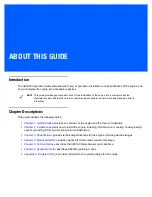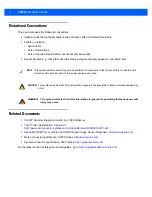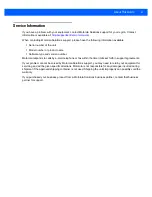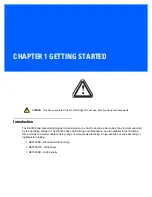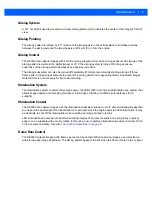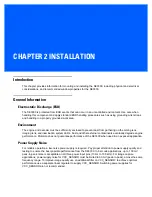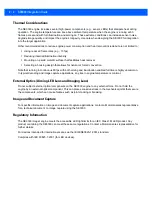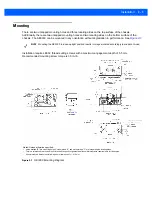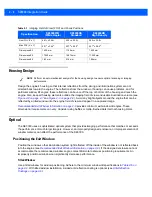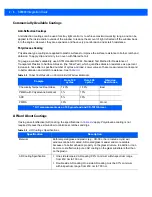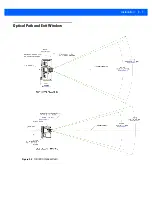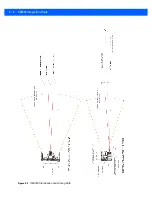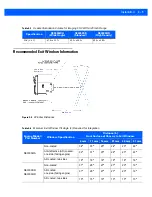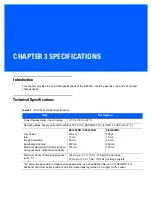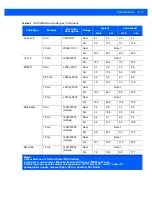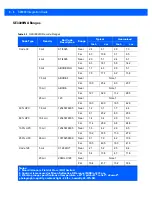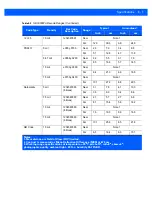
Installation
2 - 5
Avoiding Scratched Windows
Scratches on the window can greatly reduce the performance of the imaging system. Motorola recommends
recessing the window into the housing or applying a scratch resistance coating.
Window Material
Many window materials that look clear can contain stresses and distortions that reduce performance. For this
reason, use only cell-cast plastics or optical glass (with or without an anti reflection coating, depending on the
application). Following are descriptions of three popular window materials: chemically tempered float glass,
PMMA, and ADC (CR-39
TM
outlines the suggested window properties.
Chemically Tempered Float Glass
The preferred window material, glass is hard and provides excellent scratch and abrasion resistance. However,
unannealed glass is brittle. Increasing flexibility strength with minimal optical distortion requires chemical
tempering. Glass cannot be ultrasonically welded and is difficult to cut into odd shapes.
Plastics
Plastic materials are not recommended for tilted windows since surface scratches cause image artifacts.
Colored windows are not recommended if motion detection mode (e.g., presentation mode) is required since it
reduces engine sensitivity to the moving target. If using plastic is necessary, the following two materials are
available.
Cell Cast Acrylic (ASTM: PMMA)
Cell Cast Acrylic, or Poly-methyl Methacrylic (PMMA) is fabricated by casting acrylic between two precision
sheets of glass. This material has very good optical quality, reasonably good impact resistance and low initial
cost, but is relatively soft and susceptible to attack by chemicals, mechanical stresses, and UV light. Therefore
polysiloxane coating is strongly recommended. Acrylic can be laser cut into odd shapes and ultrasonically
welded.
Cell Cast ADC (ASTM: ADC)
Also known as CR-39
TM
, Allyl Diglycol Carbonate (ADC) is a thermal-setting plastic produced by cell-casting.
Most plastic eyeglasses sold today are uncoated, cell-cast CR-39. This material has excellent chemical and
environmental resistance, and reasonably good impact resistance. It also has quite good surface hardness,
and therefore does not have to be hard-coated, but may be coated for severe environments. This material
cannot be ultrasonically welded.
Table 2-2
Suggested Window Properties
Property
Description
Material
Clear cell-cast acrylic
Thickness
0.06 in. (1.5 mm)
Wavefront Distortion (transmission)
0.2 wavelengths peak-to-valley maximum and 0.04
λ
maximum rms
over any 0.08 in. diameter within the clear aperture
Clear Aperture
To extend to within 0.04 in. of the edges all around
Surface Quality
60-20 scratch/dig
Summary of Contents for SE3300
Page 1: ...SE3300 INTEGRATION GUIDE ...
Page 2: ......
Page 3: ...SE3300 INTEGRATION GUIDE 72E 148589 01 Revision 8 September 2011 ...
Page 6: ...iv SE3300 Integration Guide ...
Page 10: ...viii SE3300 Integration Guide ...
Page 14: ...xii SE3300 Integration Guide ...
Page 18: ...1 4 SE3300 Integration Guide ...
Page 38: ...3 10 SE3300 Integration Guide ...
Page 44: ...4 6 SE3300 Integration Guide Figure 4 5 SE3300 to PL33XX Decoder 21 Pin Flex ...
Page 58: ...5 14 SE3300 Integration Guide ...
Page 68: ...6 10 SE3300 Integration Guide ...
Page 70: ...A 2 SE3300 Integration Guide ...
Page 72: ......
Page 73: ......



